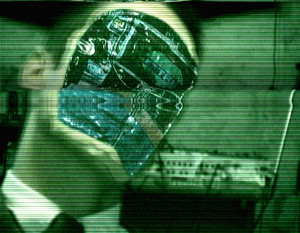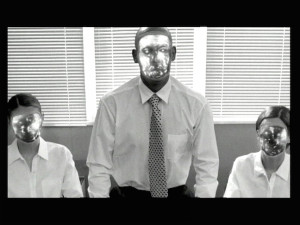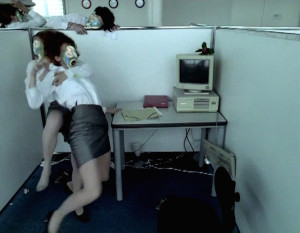ON SEPTEMBER 11, 2001, the Chaos Computer Club (CCC), Europe’s largest association of hackers, transformed the facade of the Haus des Lehrers building near Berlin’s Alexanderplatz into an interactive computer screen showing a beating heart. One of many public hacks launched by the organization, this interactive light installation, called “Projekt Blinkenlights,” ran for half a year as a site where Berliners could share movies and messages with friends and loved ones by simply using their phones to activate the building-turned-screen.
The installation’s appearance coincided with the attacks on the World Trade Center; members of the CCC soon realized that they “could have created panics,” according to Tim Pritlove, podcaster and early member of the CCC. Pritlove, who designed the installation — initially intended to commemorate the passing of the CCC’s founder, Wau Holland — explained the group’s decision to play a film of a beating heart, submitted by a young woman, as “a message to just stay calm.” After the chaos settled in the days following the attacks, Projekt Blinkenlights “became what we wanted it to be: something funny… reclaiming public space and making it available for people to play with.”
Six months later, when he announced that the installation had to be taken down, Pritlove recalled, “People were really screaming at me, ‘No you can’t take it away from us. It’s Berlin!’” The installation introduced the CCC to the city; it was an important way to address the public and say, “We are these hacker guys, we do funny stuff, we do nice things” — and its participatory nature led people to feel as if it was their own. Yet it was also a platform for the CCC to voice its political agenda, which it did partially by running an animation of so-called TLA’s (three letter acronyms) on the facade. As Pritlove explained, “One of us programmed an algorithm that took just a bunch of TLA’s in a text file and was sorting them by just exchanging a single letter… And then we put it all in — NSA, CIA, all those TLA organizations of the world… Because just by looking at the building and seeing how you just have to change one letter, it [created] a very strong message.”
Since this public debut, the CCC has been central to hacktivism’s transition in Berlin from a little-known subculture into a powerful and highly visible arm of the city’s activist left. The CCC’s origins reveal how Berlin’s not-too-distant culture of surveillance, censorship, and police control served as an incubator for a subterranean hive of hackers with bristling sensitivity to these topics. Although the club was founded in Hamburg in 1981, Berlin became the natural home for its particular brand of activism, due to a combination of the city’s political significance as the German capital, its progressive music and arts scene, and the tension between its dual East-West histories. The CCC’s mission statement describes the organization as “providing information about technical and societal issues, such as surveillance, privacy, freedom of information, hacktivism, [and] data security.” For decades, the CCC has staged public hacks to advocate for political change and call attention to the possible implications of technology, good and bad.
The CCC got its start when founder Wau Holland organized a meeting of programmers in Hamburg called the Tuwat meeting ("Do Something") to discuss the future of digitization. In 1981, there was no internet, there were few computer networks, and home computers were not widely available. I met with Pritlove in his recording studio in the quiet Berlin neighborhood of Prenzlauerberg to discuss the club’s origins. “There were some people who were actually getting what computers were, what they could mean then, what digitization of the world could mean,” he explained. “We were able to think ahead, like, ‘Okay, what if we have networks, what if we are able to exchange data — what does that mean? What does it mean for media? What does it mean for politics? What does it mean for society? And for education and so on?’ All these ideas were already there and [Wau] was looking for other people to discuss this with and to have a meeting on this.”
The CCC grew out of a period of chaos as Germany underwent a radical re-thinking of its politics. In the 1960s, student riots broke out all over West Germany in response to a perceived failure of denazification in the West’s Federal Republic of Germany (FRG). Frustration with the pace of student protestors’ attempts to change the old establishment from within led to the emergence of the radical terrorist group, the Red Army Faction, in 1970. In 1978, Berlin’s leftist movement gave rise to the founding of die Tageszeitung, a progressive daily paper that has often supported the Green Party, which itself began in Berlin in 1979. The Chaos Computer Club takes its name from the era’s prevailing spirit. As a new generation of Germans felt compelled to question the institutions and political systems that came before them, hackers in the CCC embraced “discordianism,” a philosophy of chaos, as central to their political ethos.
By the mid-80s, the CCC had gained momentum in West Germany as a group of internet activists and were beginning to launch increasingly public hacks. One instance that brought the club early notoriety in the FRG was the 1984 hack of the German post’s Bikdschirmtext computer network, which caused the system to transfer the equivalent of 150,000 DM (Deutsche Mark) to a Hamburg bank account controlled by the CCC. Pritlove explained that this fee “was never really paid because before anybody could notice, the CCC was already on the news,” making the public aware of the flaws in the system.
Just before reunification began, hackers from both sides of the Berlin Wall held the CoCon Congress, a secret meeting in East Berlin, where they talked strategy and got to know one another. (Berlin-based hackers in the Soviet-occupied East and the Allied West had discovered each other’s networks from across the wall by 1989.) After reunification, hackers from both sides of the wall “melded in an instant,” Pritlove said. “We found out that while it might have been more important for survival in the East, this tinkering approach and take it apart approach was also part of the logic of the Western hacker too. That’s why the CCC Berlin was really a 50-50 mix… In that sense, we were really a wonderful part of the reunification project because it really worked well. We were really more focused on where we want to go.”
Hackers, alongside artists, techno clubs, and radical political groups “took possession of the city’s abandoned buildings in the 90s,” explains Gregor Sedlag, a media scholar, technology blogger, and conceptualizer of “c-base,” otherwise known as “The Mother of All Hacker Spaces.”
“Hackers already associated with West-German Chaos Computer Club took advantage of the formerly secret telecommunications infrastructure of East Germany’s Stasi (Ministry for State Security) to establish free stable landline connections to the internet,” Sedlag said. Furthermore, many of the subsidies coming from the former West German government during reunification were “put towards developing new job opportunities through IT and telecommunications innovation. One such beneficiary was ART+COM e.V., which became an incubator for hacker-driven startups and innovations in the media arts.”
Meanwhile, Berlin’s long pent-up energy as a once-divided city had erupted in a torrent of punk, techno, and radical art. In anxious and anarchic waves, the low rumble of techno was already filling the city’s many abandoned buildings. The futurism of techno’s industrial sounds offered a language with which Berliners could redefine themselves. “The combination of low rents, multiple universities, and the counter-cultural heydays of techno turned Berlin into a magnet for a whole generation of Germans eager to express their freedom,” said Sedlag. Techno also inherited the rebellious, DIY ideology of Berlin’s punk culture. Anyone could DJ, mix sets, or create fanzines, and these low barriers to entry democratized the music scene by encouraging everyone to get involved and create music. But the anti-authoritarianism of techno was not confined to the city’s music scene; it also underlaid the city’s squatter, politically radical — and most pertinently, its hacker communities. Berlin’s punk principles of egalitarianism and rebellion partially developed under life in the GDR, where a DIY spirit reigned under cover as East Germans had “to do more with less,” as Pritlove explained. Hackers from the East passed on this punk approach to hacking to the West.
As punk infused the city’s cultural life after reunification, the shared values of the hacker and art scenes inspired numerous collaborations. Alec Empire of the Berlin-based, digital hardcore punk band, Atari Teenage Riot, gave the opening speech at the 31st annual Chaos Communication Congress of the CCC, which was held in Hamburg in December 2014 and drew approximately 12,000 attendees. Atari Teenage Riot itself began in 1992 as an anti-Nazi music collective, when neo-Nazism was on the rise in East Germany after the fall of the GDR. The music video for the band’s iconic song “Revolution Action” was banned in 1999 by the UK’s MTV. The video showed a virus spreading from computer screens to the minds of Wall Street workers, distorting their faces into metallic, amorphous shapes and inspiring a riot among employees as they destroy their workplace.
Empire, who grew up in West Berlin, is an activist for hacktivists. At Congress, Empire spoke about the ways the fight against surveillance, the fight against creators’ rights, and the fight for privacy are intertwined. We met to talk about his involvement with the Berlin hacker scene in a run-down, occupation-era café in the West Berlin neighborhood of Schöneberg. Electronic music, Empire said, had similar origins to the German hacker movement: “Everything after World War II, everything that led up to the Nazi regime, to the Third Reich, was a mistake, so we needed to question everything… We needed to find a new language, a new way to create music.”

Empire explained that Atari Teenage Riot’s latest album, Reset, was inspired by the revelations brought about by Edward Snowden and WikiLeaks. He and bandmates Nic Endo and Rowdy SS dedicated Reset to “hackers, activists, DJ’s, and riot grrls,” and produced the album out of concern for the impact of surveillance on artists, especially on those whose work is politically impolite. “You’re less creative if you feel like the NSA or people like that look over your shoulder while you’re writing a song. We know from German history, how that can lead to a really dangerous society — and also to really bad art — that’s my main concern,” Empire said. He also revealed that hacktivist and writer Frank Rieger asked him at the Berlin premiere of Citizenfour, Laura Poitras’s Oscar-winning documentary about Edward Snowden, to give this year’s keynote lecture at the Congress. In 2012, Rieger and another CCC member, Constance Kurz, won the organization a Werner-Holtfort Prize for citizen-and human rights engagement.
The relationship between hackers and electronic musicians in Berlin is also tactical. Members of the CCC assist local artists with the wireless light displays and voice-over IP telephones for their shows in exchange for live performances at CCC events and assistance in decorating the Hamburg Congress Center (where the CCC holds its annual Chaos Communication Congress) to look like a scruffy, warehouse-style Berlin techno club, complete with wooden tree houses, smoke machines, and DJ booths.

This past year’s Congress also drew together an impressive group of filmmakers, journalists, and artists, such as director Laura Poitras, Sarah Harrison of WikiLeaks, and the performance installation artists from The Machine to Be Another project. The hacker collective’s engagement with the art world and the media has brought its activism beyond the tech community and into public discourse, with an especially wide audience in Berlin. Poitras’s film, which was written and edited in Berlin, is a perfect example of this. In the film, she uses a PCP encryption system to exchange secure messages with Edward Snowden. She has since become an advocate for the development of privacy-enhancing technologies and cryptology as prerequisites for secure communication between journalists and their sources.
“It’s the places that make the difference,” said Sedlag, who linked hacktivism’s popularity throughout the city’s diverse cultural spheres to the growth of the Berlin hacker spaces, which he argued are “solid ground to meet and mingle, to share resources and organize bigger schemes, conferences and festivals.” The export of the hacker space is also a salient example of the CCC’s increasingly global impact. According to Pritlove, the hacker space was first developed as a concept in Vienna and then adopted by the CCC throughout Germany. He explained when the CCC had its first Camp in 2007, a convention that takes place once every four years during the summer, “there were ten, maybe 15, hacker spaces in Germany.” Many American hackers attended the Camp that year and “took a bus travelling around to all of these hacker spaces in Hamburg and Berlin,” after which, “they said, ‘Why the hell do we not have this in the US?’ It just didn’t exist — there were no hacker spaces… There was no place you could go to find people who are interested in the same tinkering business… but it was all well in Germany.” When these Americans returned home from the CCC Camp, they immediately started building hacker spaces, such as NYC Resistor, Noisebridge, and more, which all cropped up just after the Camp in 2007 and now have huge international followings. There are now more than a thousand hacker spaces around the world listed on hackerspaces.org.
Berlin’s history of surveillance and police states created an environment in which hacktivism could thrive. And with the influx of tech startups and gathering places for European hackers in the past decade, the prominence of hacktivism in the cultural and political life of the city has only taken off. As Sedlag explained, “Tech start-ups create a skilled and professionally trained workforce, helping to keep young talents and high potentials in the city… and pay them enough money to allow them to contribute to the hacker scene in their spare time.” Three of the most important European conferences on the internet, hacker culture, and the media, according to Sedlag — re:publica, transmediale, and the CTM Festival — are also all hosted in Berlin. In recent years, they have become extremely popular with the Berlin public. It’s for this reason that Sedlag was quick to note that hackers “are just one faction of the greater and diverse phenomenon of the so-called Netzgemeinde,” or digital rights community. “It’s also comprised of full-time activists, as well as people from academia, the media, and the arts.”

The Berlin hacker community now reaches individuals far outside the ranks of hackers, through festivals, art installations, and inspiring techno records. It is building channels of international proportions for its outreach. Johnny Haeusler, founder of the social media conference, re:publica, which just took place between May 5 and May 7, explained how the conference has grown from an “insiders’ gathering” to draw participants from farthest corners of Berlin’s cultural life: “We realized that digital technologies and net politics weren't just a thing for some geeks and geekettes or nerds anymore, since everything in everybody's life was being influenced by digital media and tech. We realized that there was no difference anymore between living online or offline. So we decided to become a conference for the digital society. Which basically means: For everybody.”
¤
LARB Contributor
Jane Cavalier is a Fulbright Research Scholar in Berlin, where she is studying the intersections of politics, feminism, and technology in contemporary German art history.
LARB Staff Recommendations
Writing While Muslim: The Freedom to Be Offended
Why am I told that by opposing the free speech award, I fail to prove myself as the "good" Muslim, vocally secular and eager to clap hard for Charlie...
Myth, Magic, and Mysticism in the Age of Information
The afterword to the new edition of "TechGnosis."
Did you know LARB is a reader-supported nonprofit?
LARB publishes daily without a paywall as part of our mission to make rigorous, incisive, and engaging writing on every aspect of literature, culture, and the arts freely accessible to the public. Help us continue this work with your tax-deductible donation today!
:quality(75)/https%3A%2F%2Fdev.lareviewofbooks.org%2Fwp-content%2Fuploads%2F2015%2F05%2Fblinkenlights.jpg)